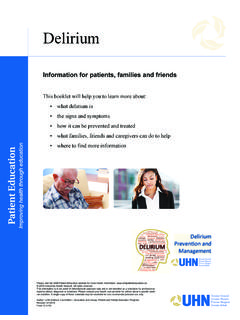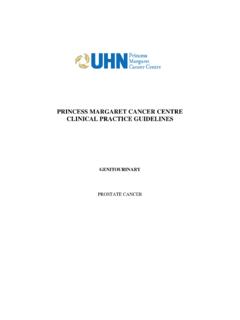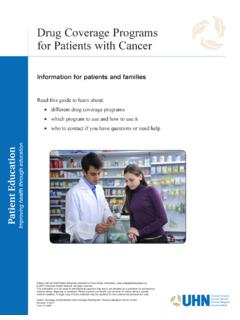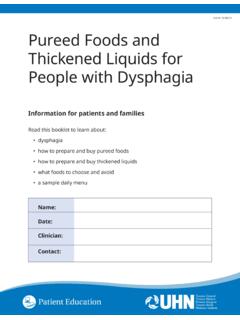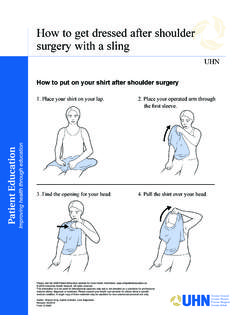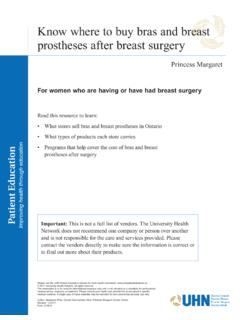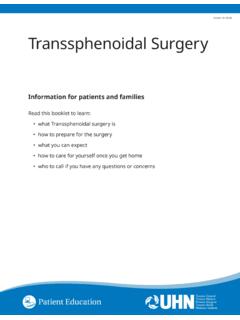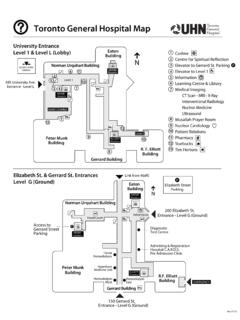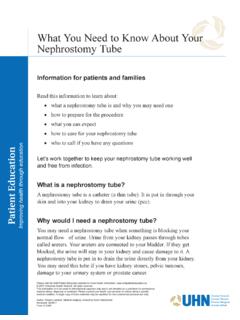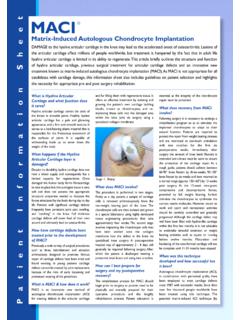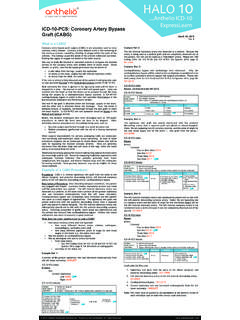Transcription of Your guide to having an In-patient Autologous Stem Cell ...
1 Please visit the UHN Patient Education website for more health information: 2014 University Health Network. All rights reserved. This information is to be used for informational purposes only and is not intended as a substitute for professional medical advice, diagnosis or treatment. Please consult your health care provider for advice about a specific medical condition. A single copy of these materials may be reprinted for non-commercial personal use only. Author: Autologous Stem Cell Transplant and Multiple Myeloma/Lymphoma Disease Site Groups Created: 12/2014 Form: D-8521 For in- patients (staying in hospital) with multiple myeloma, lymphoma, and other disorders Read this guide to learn: What an Autologous stem cell transplant is If an Autologous stem cell transplant is right for you How an Autologous stem cell transplant works How to prepare for your stay in hospital What to expect during your Autologous stem cell transplant What to expect during your recovery For more information on how to get to the hospital, services and resources, and places for your family and friends to stay near the hospital, visit.
2 For the Princess Margaret Cancer Centre Click on patients & Families , then click on guide to Princess Margaret . for Toronto General Hospital Click on Maps & Directions at the top of the page for directions to the hospital. Click on patients & Families for hospital services, resources and places to stay. UHN Your guide to having an In-patient Autologous Stem Cell Transplant 2 Table of contents Important phone 3 Understand what an Autologous stem cell transplant is How the transplant 5 Know if a transplant is right for 8 Make a decision about the 12 Prepare for your Autologous stem cell transplant Get your stem cells mobilized (to prepare for collection).. 16 Get your stem cells 21 Prepare for your stay in hospital Get your Hickman 27 What to do while you wait for your 28 During your stay in hospital (get your Autologous stem cell transplant) Get high-dose 30 Infuse your stem cells (get your Autologous stem cell transplant).
3 32 Recover in hospital Your blood count 35 Know what happens during your transplant 36 Manage your high-dose chemotherapy side 38 Learn how to cope emotionally after your 42 Go home after your Autologous stem cell transplant What to expect during post-transplant clinic 50 Vaccinations (shots) after 50 Manage 51 3 Important phone numbers Transplant Coordinators Available Monday to Friday, 9:00 am 5:00 pm Myeloma, Amyloidosis, and other Plasma Cell Disorders Andrew Winter Phone: 416-946-4583 Myeloma, Amyloidosis, and other Plasma Cell Disorders Allyson Mayo Phone: 416-946-2985 Lymphoma, Germ Cell Cancer, and Acute Leukemia Denise Turvey Phone: 416-946-4689 Transplant Office Location: The Princess Margaret Cancer Centre, 5th Floor Phone: 416-946-4501, extension 5082 Out-patient Transplant Day Hospital Location: The Princess Margaret Cancer Centre, 14th Floor, Room 627 Phone: 416-946-6555 In-patient Transplant Ward Location: The Princess Margaret Cancer Centre, 14th Floor (14C) Phone: 416-946-2011 Apheresis Unit Location: Toronto General Hospital, Gerrard Wing 2nd Floor Phone: 416-340-3999 Write down and keep track of all your appointment dates and times in: Princess Margaret BMT Program Pre-Transplant guide 4 Understand what an Autologous stem cell transplant is What are stem cells?
4 Stem cells are found in your bone marrow (spongy tissue inside your bones). Stem cells can form different blood cells, like: red blood cells, white blood cells, platelets, and make more stem cells. What are Autologous stem cells? Autologous stem cells are your own healthy stem cells that have been collected and cryopreserved (frozen). What is an Autologous stem cell transplant? Autologous stem cell transplant is used to treat people who have different cancers, such as Multiple Myeloma and Lymphoma. Other non-cancer diseases such as Amyloidosis may also benefit from transplant. In order to destroy as much of your cancer as possible, a very high dose of chemotherapy treatment called high-dose chemotherapy is given. This chemotherapy will also destroy your bone marrow where you make blood cells.
5 Since you cannot live without blood cells, the high-dose chemotherapy must be followed by an infusion (giving you back through an intravenous, also known as IV ) of your own stem cells. This infusion of your stem cells is called an Autologous stem cell transplant . This will allow your bone marrow to grow back, and start making blood cells again. The infusion of stem cells is called a stem cell rescue , since it is rescuing your normal bone marrow from dying. Without the Autologous stem cell transplant, patients would not be able to get high-dose chemotherapy to treat their cancer. 5 How an Autologous stem cell transplant works There are 9 major steps involved in getting a transplant. More details about each step will be given in the rest of this booklet.
6 Step 1: Know if a transplant is right for you, and plan for the transplant. Your cancer and overall health are checked to see if an Autologous stem cell transplant is the right treatment for you. You will need to do some basic tests and procedures as part of this assessment. Your health care team needs to know if your cancer is under control, how much of it is still there, and if your body can handle the transplant. Your health care team at the Princess Margaret includes: your transplant doctor (hematologist), nurse practitioners, specialized transplant clinic and In-patient nurses, transplant coordinators, administrative assistants, and training doctors (called residents or fellows). Your health care team will also assess if you should stay in hospital during the transplant ( In-patient transplant), or if you can stay at home and visit the Out-patient Day Hospital daily after the transplant (out-patient transplant).
7 This information booklet will discuss the steps for an In-patient transplant. Step 2: Stem Cell Mobilization Moving your stem cells into your bloodstream is called mobilization . Your healthy stem cells need to be collected and cryopreserved (frozen) before you can get high-dose chemotherapy. Since stem cells live in your bone marrow and they are collected from your bloodstream, you will need treatment to move your stem cells from your bone marrow into your bloodstream. The process of stem cell mobilization uses a drug called Filgrastim (Neupogen ), with or without chemotherapy. The chemotherapy works together with the Neupogen to make stem cells move into your bloodstream. For most patients , both chemotherapy and Filgrastim (Neupogen ) are used for mobilization.
8 In a few cases Neupogen alone is used. Your health care team will let you know what will be used in your case. 6 Step 3: Collect your stem cells Your stem cells will be collected by a process called apheresis . During this process: Your blood is run through an intravenous (IV) line into the apheresis machine where the stem cells are removed from your blood and collected. The rest of your blood is then returned to your bloodstream. The apheresis machine is similar to the machine used by patients with kidney disease who have their blood cleaned by dialysis. Once the stem cells are collected by apheresis, they are cryopreserved (frozen) until you are ready for the transplant. Step 4: Get a Hickman line put in When you are ready to have your transplant, you will need a Hickman line.
9 This is a special intravenous (IV) line that is put into one of the large veins under the collar bone or in your neck. The Hickman line is used by the nurses to: take blood samples during your transplant. give you high-dose chemotherapy and infuse your stem cells. give you transfusions of blood and platelets, extra fluid and supplements, and antibiotics (medicine that fights infection). Step 5: Admission to (staying in) hospital After the Hickman line is put in, you will be admitted to hospital for the transplant. Since there may be a wait to be admitted to the transplant unit at Princess Margaret you may need more chemotherapy treatment while you wait. Your health care team will let you know if you need more treatment. Step 6: During your stay in hospital Every day you are in hospital, you will be assessed by the nurses, nurse practitioners, and doctors.
10 They will assess your blood levels, what side effects you may be feeling, and whether you need any: transfusions replacement of any fluids and electrolytes (minerals) your body needs antibiotics (medicine that fights infection) tests to check for infections Otherwise, you can rest or sleep, have visitors, and go for walks in the hallways. 7 Step 7: Get your high-dose chemotherapy Once you are in the hospital, you will get high-dose chemotherapy to destroy your cancer and bone marrow. The chemotherapy you get may be given in one dose or in many doses over several days, depending on what your health care team decides. You will get extra medications to help prevent nausea and vomiting from chemotherapy and intravenous (IV) fluids to help flush the chemotherapy out of your system.
